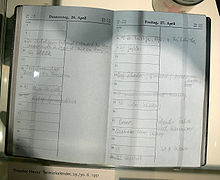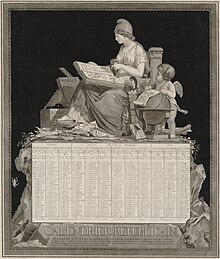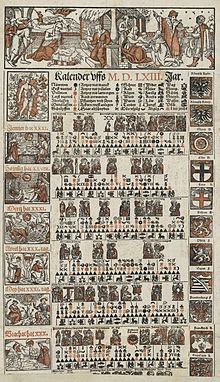Calendar
A calendar ( Medieval-. Kalendarium , late Latin. Calendarium = debt register of lenders to: Calendae ) is a list of days of the year depending on the type of calendar is divided by week, month, etc. organized or individual days. Originally, a calendar referred to a register in the Roman Empire for the date of debts due. In Christianity it is an official directory for church feast days and days of remembrance.
Demarcation
A calendar is a compilation or presentation of calendar data in order to ensure a chronological overview:
- as a written calendar over a more or less long period of time: the calendar in the general language sense, as a notebook, tear-off pad, wall calendar or in electronic form
- as an appointment calendar to include additional information or notes, e.g. B. on a specific topic such as event information , the work processes in a company, the organization of tasks to be done ( to-dos )
- as an agenda (lat. agendum "the thing to be driven") as a memory aid ( memo book ): diary , agenda , action program
- as a chronology of a specific historical period or historical development
- as a scale on the meridian line of a meridian instrument (astronomical measuring instrument, see Solarium Augusti )
etymology

The term calendarium originally comes from Latin and in ancient Rome meant debt register , since debts had to be paid on the calendars , the first day of each month. Later it simply became the calendar , which the Romans called festis .
In the course of time the meaning of the word calendar has changed, today it encompasses pretty much all aspects of the calendar .
In particular, the calendar is used to write down a physical calendar , print it , display it in electronic form or by clocks , to separate it from the ideal calendar (the calculation rules of the calendar calculation ).
Calendar in use
Printed calendars

Printed calendars are usually made for one calendar year. A single sheet comprises a day, a week, a month or a whole year .
The common forms of calendars are designated according to the format wall calendar , pocket calendar or, according to the binding, single-sheet calendar , calendar block ( tear-off pad ) or calendar booklet ( notebook ). The watch strap calendar is a special feature .
Calendars simply serve as an overview, as decoration , or as a memorandum (booklet) - appointment calendar , event calendar , astronomical calendar ( ephemeris ) - or as a memoire (diary).
Wall calendars are available in a wide variety of forms, e.g. B. tear-off calendar , picture calendar , especially as an art calendar , or disposition calendar as a magnetic board .
- The classic tear-off calendar provides a sheet of paper for each day of the year, on the back of which often astronomical dates and / or sayings , recipes , puzzles can be found, and calendar stories as a historical form . There are also thematically oriented tear-off calendars on topics such as history, geography, philosophy, art and literature or language calendars .
- Picture calendars often show landscapes, but can also be dedicated to many other topics. Often, like most art calendars ,they showa month per sheet. Thematic wall calendar, which often mix text and image (eg. As Literaturkalender , film calendar ), often also have a weekly or bi-weekly sheet sequence.
Another category are note calendars in different formats, as pocket calendars or calendar booklets, in small formats (such as credit card format ) that you can always carry with you. Here one can again distinguish between pure note calendars, which, in addition to a printed calendar in the appendix, only contain important data (e.g. postage or telephone prefixes, etc.) and thematic calendars that add amounts next to them - between the calendar sheets and / or after the calendar a specific topic (e.g. women's calendar , sowing calendar , etc.).
Calendar booklets in the form of periodical publications: the best-known form is the writing calendar in quarto format , with a relatively solid appearance from around the middle of the 16th century to the present day.
In addition to the calendar, job-related calendars contain job-related articles and aids (e.g. teacher calendars with lists of grades).
Calendars are a popular promotional gift that companies give their customers at the turn of the year.
Electronic calendars
A computer is particularly suitable for calculating and presenting calendars in a clear manner, as well as reacting quickly to changes and processing or executing the additional calendar data. Therefore, calendars have spread very quickly in data processing :
- General calendar programs are available in a variety of ways in the operating system and as a stand-alone application
- Notepad programs remind human users of things to be done (" to do ", see to-do list )
- Task planners carry out service work of a computer system entered in a calendar
- Time-dependent access authorizations to electronic resources, e.g. for DHCP refreshes or access rights
- Astronomical ephemeris are fundamentally built into most astronomical programs
- Specialized programs are available for problems of timing ( scheduling ) in business and computer science
- In payroll accounting, calendars are used which show working hours and absenteeism (illness, vacation ...) for each employee and day of a accounting period. Many payroll programs (e.g. DATEV Lodas) also allow data to be entered in calendars.
Mobile phone, laptop or PDA can be used with special software as an electronic appointment calendar ( Personal Information Manager , e.g. GPE Palmtop Environment ) for these tasks. Various links to other tasks and other people can be established in software and via wireless network connections ( SMS , e-mail , groupware ).
Calendar of saints
In the Catholic Church it is used in particular to assign saints to the days of the year (also called saints calendar ).
A special form of calendar is the Cisiojanus , a memorial poem that helps date the immovable saints and holidays of the Roman Catholic Church. It spread from the end of the High Middle Ages and was in use until the early modern period .
history
Historical annual calendars are hardly ever limited to the mere representation of the course of the year, but also provide information on seasonal activities, agricultural tasks or weather conditions to be expected in the course of the year and are therefore also called farmers' calendars . The so-called bloodletting man was one of the indispensable components of the calendar right into the 19th century. For example, the Calendarium Romanum from the Interlaken Monastery (Johanna von Arberg and Agnese Stollera, 1446) already uses the bloodletting figure to show which zodiac signs govern the individual areas of the body and are therefore suitable for bloodletting for certain ailments and for certain star constellations . The best days for cutting hair, bathing, cupping, weaning, etc. were also given. Such information can be found throughout the middle of the 18th century (e.g. in the centenary calendar ), when in the course of the popular enlightenment attempts were made to ban superstition from the calendar (for example through the Prussian calendar reform of 1778/79). When these reform efforts failed, the bloodletting figure, or at least a bloodletting table, returned to the calendar (as in the "New Berner Calendar", edited by Jeremias Gotthelf , 1840–1845). Contemporary astrological lunar calendars take up this direction again.
Calendar and public education
Even in the early non-profit Enlightenment , which has led to a broad enlightenment of the people since the 1760s, efforts were made to use the medium of the calendar for practical and economic, and later above all edifying and moral instruction of the population. The calendar reached the broadest sections of the population like hardly any other reading material. Before the widespread distribution of daily newspapers , it was also the most important information medium.
The calendar reformers of the 18th century wanted to include agricultural and household information, medical and veterinary advice alongside edifying stories in the calendar for the economic benefit of both the reader and the fatherland. The old superstitions should be banned as well as the frequently represented narratives of merely strange or spectacular occurrences which could not have any immediate benefit for the reader. With legal regulations one tried to enforce reform calendars in a market that was characterized by reading habits and well-established popular calendars. The attempts, some of which were radical, often failed right from the start: Readers would rather not buy a calendar than the successor to their traditional notebook created by scholars and state officials.
Folk calendar
From the failure of the first reform efforts a popular education movement developed , which now took the reading interests of calendar readers much more into account and in some cases preferred to retain the bloodletting man in order to find a receptive readership for the instructive stories ( calendar story ). The example those incurred even in the early modern period, people calendar was the Rheinische family friend of Johann Peter Hebel ; He was followed by well-known authors such as Heinrich Zschokke , Berthold Auerbach , Jeremias Gotthelf , Alban Stolz and numerous calendar makers of the 19th century. In addition to the daily newspaper, the calendar also held a central position among popular reading material in some regions until the 20th century.
Farmers calendar
Farmer's calendar refers to traditional calendars that have been created for centuries for the rural population who are ignorant of reading and later often also took into account regional weather rules, lost days and the farmers' experience; something like this:
- Admonter farmers calendar
- Old farmers calendar - also Mandlkalender from Styria
- Laibach farmers calendar
See also
- Annual calendar - annual overview in Wikipedia
- Date format ( ISO 8601 )
- iCalendar (data exchange format)
- Gregor Calendar Award
- Links to calculations
- in our calendar system: Section Weblinks in the article Gregorian Calendar
- in other systems: section Weblinks in the article Calendar
literature
- Holger Böning : Public Enlightenment and Calendar. At the beginning of the discussion about the use of traditional folk reading material for enlightenment and for the first practical experiments up to 1780. In: Archive for the history of the book. 56, 2002, ISSN 0066-6327 , pp. 79-107.
- Michael Buhlmann: Calendar of the Middle Ages. Introduction, tables, CD-ROM Internet calendar calculation. Lecture "Medieval calendar based on St. Georgen historical sources" at the Association for Local History St. Georgen. St. Georgen, May 19, 2005. Association for local history, St. Georgen 2005 ( Vertex Alemanniae issue 18, ZDB -ID 2282671-3 ).
- Friedrich Karl Ginzel : Handbook of mathematical and technical chronology . 3 volumes. Hinrichs, Leipzig 1906–1914 (reprint: ALO Austrian Literature Online, Innsbruck et al. 2007).
- Hermann Grotefend : Pocket book of the time calculation of the German Middle Ages and the modern times. 13th edition. Hahn, Hannover 1991, ISBN 3-7752-5177-4 .
- Katherina Masel: Calendar and public education in Bavaria. On the development of the calendar system from 1750 to 1830. EOS-Verlag, St. Ottilien 1997, ISBN 3-88096-886-1 ( Research on state and regional history 2), (At the same time: Munich, Univ., Master's thesis, 1991).
- Ludwig Rohner: Calendar History and Calendar. Athenaion, Wiesbaden 1978, ISBN 3-7997-0692-5 .
- Rudolf Schenda : Limping messages? On the development and importance of the Swiss folk calendar. In: Swiss Archives for Folklore. 92, 2, 1996, ISSN 0036-794X , pp. 161-181.
- Robert Schram: Calendar and chronological tables . Hinrichs, Leipzig 1908.
- Heinz Zemanek : Calendar and Chronology. Known and unknown from calendar science. An essay. 5th improved edition. Oldenbourg, Munich et al. 1990, ISBN 3-486-20927-2 .



